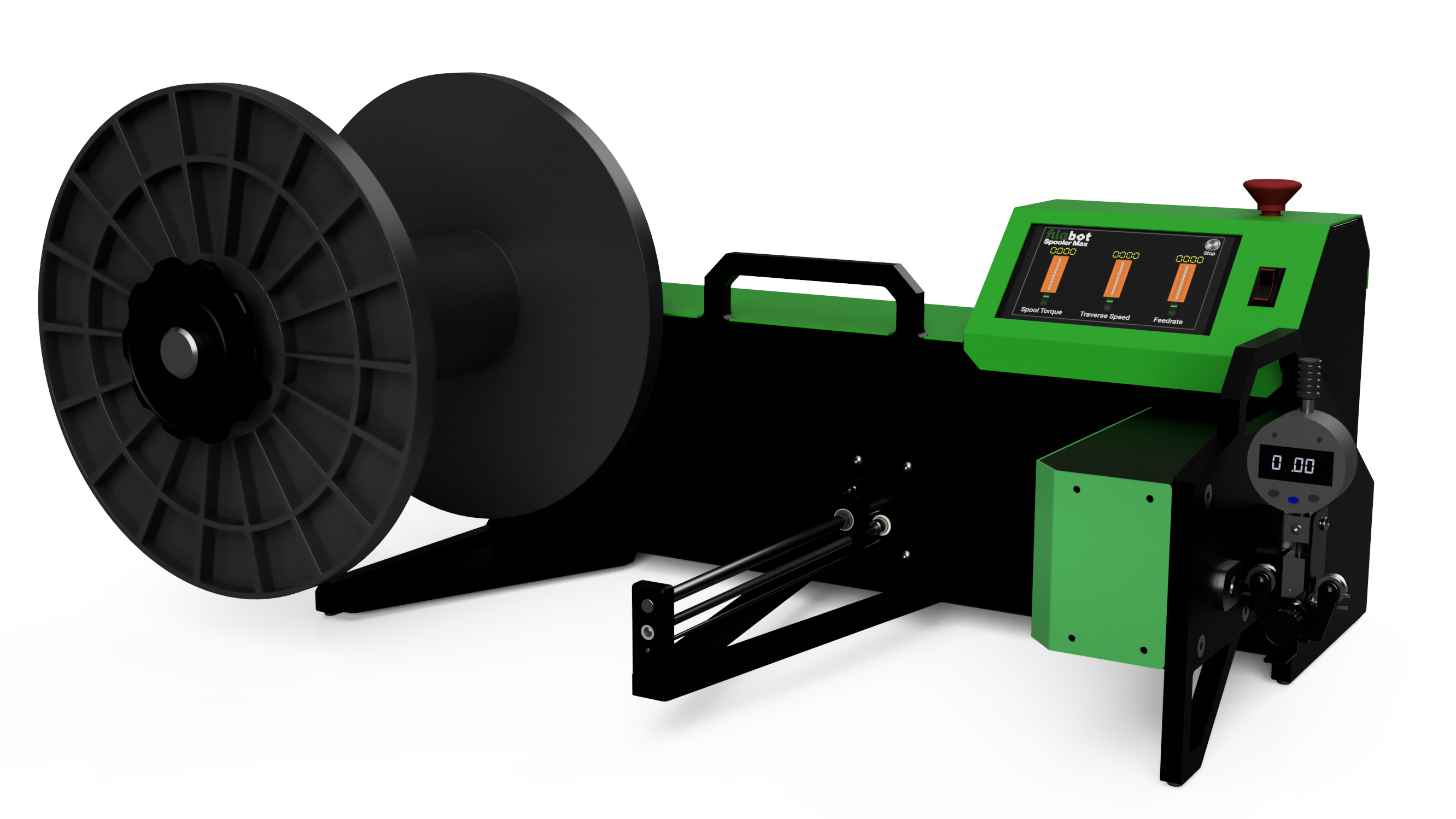We care about the materials we sell and the success of using our machines. This report was done with very extensive testing beyond what we typically do with the lab testing service we provide but a detailed processing report to give customers the best outcome, we hope that customers will take this and expand it. Work with faster settings, use additives, and get creative.
Click here to see results of PLA LX175 on a EX2
We also want customers to know that we will provide more test reports including the EX6.
NEW PRODUCT: PLA LX175 Processing Report
Material Extrusion Report
LX175 “PLA” was extruded in the EX6 to compare the tolerances of the polymer with different Filabot Accessories. From testing, we saw that the tolerances of the material improved when using the melt filter nozzles with the Standard Stock EX6 Screw. Tighter tolerances were achieved when using the Melt Filter Nozzles. The best outcome we had when conducting the test was seen when we used both the Standard Melt Filter and the Extended (2x) Melt Filter. These had moments of tolerances of 1.75mm +0.03mm diameter during testing. This was also noted during 2.85mm testing. Further testing of the material will look into printability as well as strength comparisons. Further testing will use the Chrome Screw with the EX6 Nozzles and test the polymer with different additives; lastly, 2X melt filter test is needed for the 2.85mm tolerances.
About the material: PLA is a biobased polymer derived from natural resources and offers a significant reduction in carbon footprint compared to oil-based plastics. Luminy LX175 is a high viscosity, low flow, amorphous, transparent PLA resin suitable for film extrusion, thermoforming or fiber spinning. (Corbion, 2020).
These pellets are usable with both our EX6 and EX2 systems for 1.75mm & 2.85mm filament with +/-0.05mm tolerance.
-------------------------------------------------------------------
Test Technician: Nasser Abdel-Fatah
Test Number(s): ET201029NA01-03 & ET201109NA01&02
Plastic Name: LX175
TDS: https://cdn.shopify.com/s/files/1/0236/7897/files/TDS_Luminy_LX175_Filabot.pdf?v=1602610806
Manufacturer: Corbion.
Supplier: Filabot.
Additives: None.
Material Form: Pellets Round, clear.
-------------------------------------------------------------------
Extrusion Test Notes
Material preparation: None.
Grinding: None.
Drying: Yes, 4-6hours 85C.
Extrusion Setup: EX6. Airpath(2X)*. Filameasure SPC Unit with Tablet, and Spooler.
*2 Airpaths were used for 2.85mm filament production.
Note on Extruder: Prior to extrusion of the material the machine needs to be 100% clean (both the barrel and the nozzle).
Extrusion Results: The above test numbers were able to generate filament at 1.75mm & 2.85mm with a tolerance of +0.05mm. The settings, speeds, and additions are in the correct range to generate filament. All Melt Filters used a 60 and a 20 Mesh insert.
-------------------------------------------------------------------
Test Settings:
Materials were extruded in the EX6 with the following settings:
Heat zone settings:
1.75mm
- Front: 167.5 degrees Celsius
- Middle: 166 degrees Celsius
- Back: 165 degrees Celsius
- Feed: 40 degrees Celsius
2.85mm
- Front: 167.5 degrees Celsius
- Middle: 166 degrees Celsius
- Back: 165 degrees Celsius
- Feed: 40 degrees Celsius
Fans Settings: (Same for all tests)
- Front: Mid
- Middle: Mid
- Feed: Max
- Motor: Max
EX6 Power:
1.75mm
- D.C. Volts: 20
- D.C. Amperes: 3-4
2.85mm
- D.C. Volts: 30
- D.C. Amperes: 4+
Nozzle Used:
1.75mm
- Standard Nozzle Test number: ET201029NA01
- Standard Melt Filter: Test number: ET201029NA02
- Extended (2X) Melt Filter Test Number: ET201029NA03
- Size: 1.75mm
2.85mm
- Standard Nozzle Test number: ET200709NA01
- Standard Melt Filter: Test number: ET200709NA02
- Size: 2.85mm
Screw Used:
- Standard Stock Screw Test number: All Tests.
Airpath Settings:
- Number of Airpath’s: 1 (Note 2 were used for 2.85mm results).
- Fan Speed: 100%
- Magnets: 5 used along Airpath. End, Center, Front.
- Tape: No.
Spooler Settings (0.5kg spool):
- Drive: mid
- Traverse: 30%
Notes on Equipment
The positioning of Equipment:
1.75mm
When extruding the polymer space the EX6 50mm (2in) away from the first Airpath. Space the Airpath and the Spooler 60cm (2-feet) between each other.
2.85mm
When extruding the polymer space the EX6 50mm (2in) away from the first Airpath. Have no space between Airpath 1 and Airpath 2. And space the Spooler 30cm (1-foot) between Airpath 2 and the Spooler.
About the Standard Melt Filter Nozzle:
The Filabot Melt Filter Nozzle is used to help decontaminate your recycled materials for a clean, consistent filament. This nozzle includes a stainless steel mesh screen to filter small contaminants that have slipped through the cleaning and grinding process. The filtering of these contaminants reduces the chances of clogging the printer nozzle.
About the Extended 2x Melt Filter Nozzle:
This “extra length” improves output consistency, keeping your filament extrusion to the appropriate range. Use 2X Melt Filter Nozzle to help decontaminate your recycled materials for a clean, consistent filament. The 2x nozzle improves laminar flow (less die stress at exit) and allows the filament to cool slightly during exit compared to stock. The 2x nozzle works best up to 50 volts.
Results 1.75mm:

Graph 1. Test: ET201029NA01. Stock Extrusion Testing Nozzle and Screw.
Once temperatures and power were determined on the EX6 adjustments were made to the Spooler “drive” to improve the tolerances. The material stayed in +/-0.05mm tolerance. There were two moments on the graph where it exceeded 1.8mm these two bumps were not noticed when the filament was extruded.

Graph 2. Test: ET201029NA02. LX175PLA with the Standard Melt Filter and Stock Screw. Filament maintained range of 1.75 +/- 0.04mm.

Graph 3.Test: ET201029NA03. 2X Melt Filter: With tolerances of +0.05mm and moments of +0.05mm 1.75mm.
The material stayed in +/-0.05mm tolerance. There was one moment on the graph where it exceeded 1.8mm this moment was not observed during testing. This test produced the tightest tolerances.
Results 2.85mm:

Graph 4. Test: ET201105NA01. Standard Stock Set up. With tolerances of +0.05mm 2.85mm.
Once temperatures and power were determined on the EX6 adjustments were made to the Spooler “drive” to improve the tolerances. From 09:41:00 to tick marker 09:56:00 on the graph was before the material was placed on a spool. When spooled the material had to be readjusted. Once the polymer was in a suitable range we stopped adjusting the “drive” on the Spooler. Throughout the test we noticed that there were dropouts and a moment 3mm. These moments we have noticed correlate to when the screw or barrel was not fully cleaned, this is an important step to make sure that your equipment and machine is cleaned.

Graph 5. Test: ET201105NA02. 2X Melt Filter Nozzle with Stock EX6 Set up. With tolerances of +0.05mm and moments of +0.03mm 2.85mm.
Once temperatures and power were determined on the EX6 adjustments were made to the Spooler “drive” to improve the tolerances. From 12:23:00 to tick marker 12:38:00 min on the graph the material was placed on a spool and readjusted. From tick marker 12:38:00 to the end of the test the material was in perfect range. The best outcome was seen with the melt filter nozzle.
Photos of test print:


Links for More Information & Equipment:
- PLA LX175: https://www.filabot.com/collections/filament/products/lx175-pla
- Standard Melt Filter: https://www.filabot.com/collections/components/products/ex6-melt-filter-nozzle-style-x
- Extended Melt Filter: https://www.filabot.com/collections/components/products/extended-melt-filter-nozzle
- EX6 Bundle: https://www.filabot.com/products/ex6-bundle
- Filalogger Bundle: https://www.filabot.com/collections/spooler/products/filameasure-inline-filament-measurement
Want to see more? Send us an email at contact@filabot.com if you have any questions.
Related Posts
Improve Filament Output Consistency with Melt Filter Nozzles
Use the Filabot Melt Filter Nozzle to help decontaminate your recycled materials for a clean, consistent filament. The stock nozzle is good for lower output applications where the voltage is under 25 volts.
The 2x nozzle performs better because it provides more laminar flow (less die stress at exit) and allows the filament to cool slightly during exit compared to stock. The 2x nozzle works up to 50 volts.
The 3x nozzle is used for very high index plastics like PET. It aids in the pull down on exit and allows the filament to cool even more than the 2x.
---------------------------------
FILAMEASURE Inline Filament Measurement and SPC Unit
Finally, the perfect way to measure filament while extruding. The Filabot Filameasure is the perfect addition to the Filabot Spooler, this addition mounts to the Filabot Spooler and measures freshly extruded filament.
The inline measurement allows for real time adjustments to dial in diameter for the best possible filament. No more need for consistent caliper checking with this tool. Another great feature of the Filameasure is the SPC Unit one can attach to it. With the Filalogger software one can record and save in real time filament spooled or polymers tested! This is upper handy for on the cuff adjustments and troubleshooting needs. The Filameasure and SPC unit will allow to compare and contrasts your data with other plastics and extruder settings to see what works best for you!
We feel very strongly about the value this addition can bring to you and your extrusion making! To help with the support of our product we have a couple YouTube videos you can check out here. Also, check out the Filameasure here on our website! Be on the lookout for new products to improve your recycling and extrusion needs!









